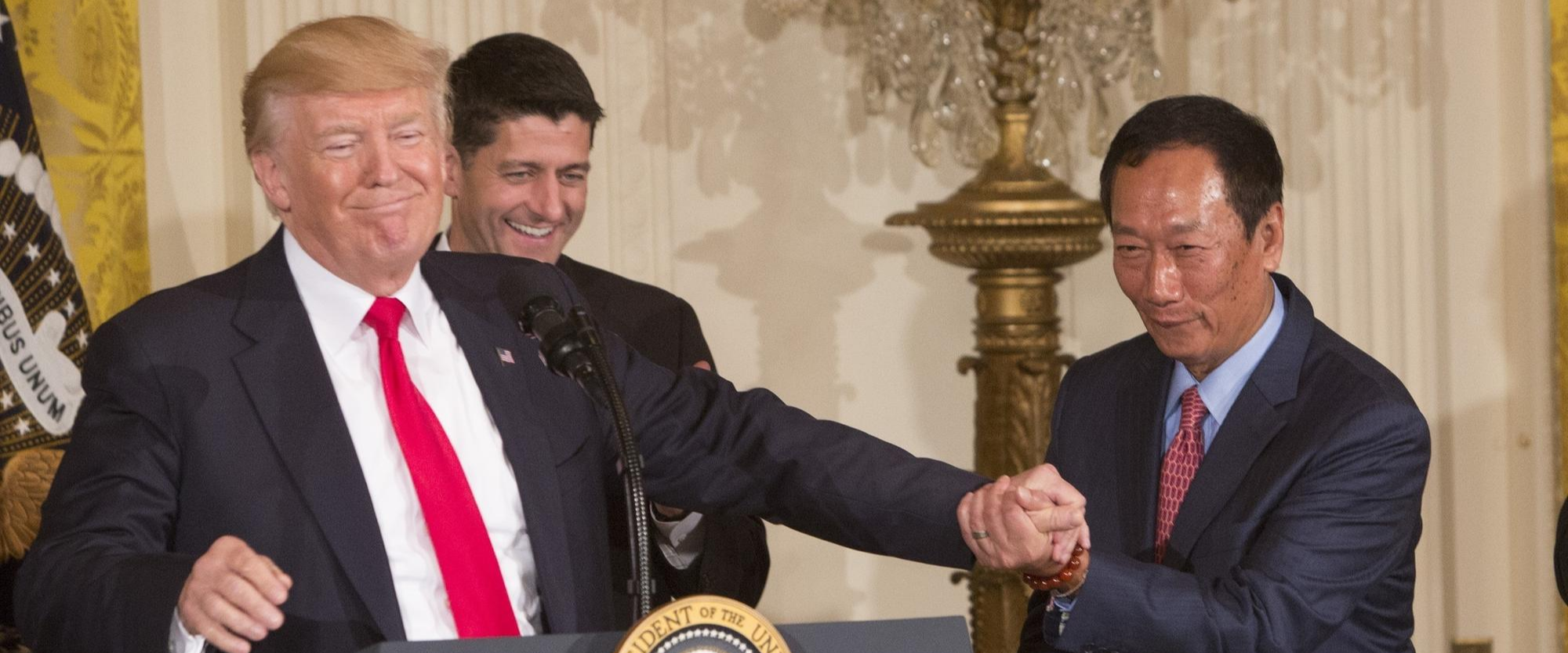Why Are 10 billion Dollars not Enough to Build a Chinese Factory in the US?

In July 2017, Foxconn went to the United States to build a factory.
During the signing ceremony, then-US President Trump could hardly contain his excitement:
With Foxconn’s support, the world became more aware of American workers’ unparalleled skills and the American dream’s limitless potential. The prosperity of American manufacturing was within reach.
However, seven years later, Americans were left shocked, realizing they had been deceived.
3000 acres, equivalent to 3.5 Central Parks in New York.
This vast land was acquired by the US government seven years ago in Wisconsin, near Lake Michigan, to attract Foxconn to build a factory.
Trump, who was determined to revitalize American manufacturing, understood the significance of Foxconn as the world’s largest contract manufacturer.
He spared no expense, promising $3 billion in tax incentives for Foxconn over the next 15 years.
In addition, the local government provided over $700 million in factory construction expenses and nearly $300 million for infrastructure such as roads and power networks.
This subsidy amount set the record for the highest subsidy ever given by the US government to a foreign company.
 Foxconn’s founder, Terry Gou
Foxconn’s founder, Terry Gou
Foxconn’s founder, Terry Gou, reciprocated by deciding to invest $10 billion in constructing a LCD panel super factory in Wisconsin, creating 13,000 job opportunities for the locals.
Once the project was completed, it would be the largest new investment ever made by a foreign company in the United States.
During the signing ceremony on July 17th, Trump excitedly proclaimed, “It’s a great day for American workers and manufacturing!”
Wisconsin, blessed with this unexpected opportunity, was overwhelmed with excitement.
“This project is a once-in-a-generation opportunity for our state.”
In the eyes of Governor Scott Walker, this investment would bring about a transformation for Wisconsin, just as Silicon Valley did for the San Francisco Bay Area over half a century ago.
The locals were already cheering:
Wisconsin Valley!
Trump showed respect to Terry Gou by putting on a show.
The following year, in June, Trump personally attended the groundbreaking ceremony. He wielded a shovel, took the first scoop of soil, and declared the manufacturing park as the eighth wonder of the world.
However, the miracle that Trump and Americans eagerly anticipated never materialized.
In April 2024, seven years later, when the current US President Biden visited the site, the vast 3000-acre land was sparsely dotted with a few buildings, and the newly constructed roads were deserted.
The most prominent landmark was a solitary giant glass sphere.
Looking at the nearly abandoned project before him, 82-year-old Biden sarcastically remarked in a tone rarely heard at his age.
“They dug a hole with those golden shovels and they fell into it.”
Over the past seven years, the American people have made significant sacrifices for this iconic project. Wisconsin and local governments spent $500 million on infrastructure, demolished hundreds of houses and farms.
They believed they would witness history, but what they received was a constantly downsized project:
The planned $10 billion investment was reduced to $1 billion, and the promised 13,000 job opportunities were reduced to less than 1,500.
America couldn’t catch Foxconn.
If this was a scam, with Foxconn being the scammer, it may have been unfair to blame it solely on Terry Gou. For Foxconn, as Apple’s largest contract manufacturer, building a factory in the United States came with enormous benefits.
Moreover, the US offered an irresistible package of conditions.
In fact, this collaboration, which Trump hailed as a perfect example of manufacturing returning to the United States, initially progressed smoothly. During the groundbreaking ceremony, he couldn’t help but exclaim:
“18 months ago this was a field, and now it’s one of the most advanced places of any kind you’ll see anywhere in the world. It’s incredible.”
However, what unfolded next went far beyond Foxconn’s expectations and even exceeded the expectations of the American people themselves.
Firstly, there were supply chain issues.
The mindset of “China can do it, so can anywhere else” has misled many companies in the past. The reality is that Wisconsin lacks the well-developed upstream industry clusters that Foxconn enjoys in China.
The local industrial layout and supply chain customers have almost no connection to Foxconn’s business.
This directly led to a sharp increase in production costs for Foxconn, including raw materials and equipment.
A bigger problem lay in the availability of labor.
High wages were just a minor issue; the crucial problem was the inability to recruit workers.
Shortly after the construction of the factory in the United States, Foxconn held a large-scale job fair.
The result was only 1,300 resumes received, and ultimately only 300 people were interviewed.
Due to the inability to hire enough engineers and workers, Foxconn had to resort to various measures, such as collaborating with other organizations, hiring veterans, and even sending Chinese engineers to the United States.
Desperate, Terry Gou complained repeatedly at an internal company meeting:
In the United States, we simply can’t find employees!
The challenges in production and operations exhausted Foxconn, and the sudden change in the market environment caught Terry Gou off guard. Shortly after the construction of Foxconn’s factory in the United States, the global panel industry took a nosedive.
The originally planned 10.5-generation LCD panel factory had to be downsized to a 6th-generation production line.
At a time when Terry Gou was feeling overwhelmed, the local state government began to backtrack.
The newly elected Democratic Governor Tony Evers refused to provide tax subsidies, citing Foxconn’s failure to meet its promised employment numbers, and demanded a renegotiation of the agreement.
By then, Terry Gou was probably contemplating retreating.
Being in the business world, he had no choice. As he watched his flagship project continuously downsized, then-US President Trump also grew anxious. He privately met with Terry Gou and proudly tweeted:
“Great news on Foxconn in Wisconsin after my conversation with Terry Gou!”
In hindsight, this turned out to be merely wishful thinking on Trump’s part.
After that conversation, Foxconn’s project in Wisconsin did not improve.
And Trump himself left the White House with a heavy heart more than a year later.
Beaten down, Foxconn finally had to accept the reality: When it comes to TVs, we have no market in the United States. They can’t compete.
Bloomberg lamented:
If Foxconn lacks competitiveness in the field of electronic product manufacturing in the United States, then there is no company that can succeed.
In April 2023, Microsoft invested $50 million to purchase a piece of land in the Foxconn park, planning to build a large-scale data center.
That became Biden’s new favorite.
The protagonist was no longer Foxconn.
Reviving the American manufacturing industry, which the United States took pride in, has been the slogan of several generations of US presidents.
In the past 40 years, with globalization and the outward migration of manufacturing, the scale of industrial output and employment in the United States has plummeted, with nearly a quarter of factories disappearing.
Although there are still many successful brands, much of America’s industrial manufacturing capability is deteriorating further:
Boeing aircraft has experienced frequent accidents in recent years, and many shipyards have closed down, forcing the US to seek help from Japan and South Korea…
The US government saw this, and it troubled them deeply.
Rome wasn’t built in a day, and the problems couldn’t be solved overnight.
As early as 2009, Obama first proposed a plan to revive American manufacturing.
During the Trump era, reviving American manufacturing was a significant goal of his presidency.
In 2018, despite the tight financial situation in the United States, Trump launched an ambitious plan: to invest $1.5 trillion in infrastructure over the next 15 years.
He also introduced multiple bills aimed at protecting American manufacturing and called on Americans to buy domestic products.
After Biden took office, despite having different governing philosophies than his predecessor, there was a high degree of agreement when it came to revitalizing American manufacturing.
Reviving American manufacturing relies on building factories. Both Trump and Biden, during their respective terms, went to great lengths to attract global manufacturing giants to establish factories in the United States.
However, once certain capabilities are lost, picking them up again becomes difficult, if not nearly impossible.
During the Trump era, Apple proposed to Foxconn, Pegatron, and other suppliers to bring back all their Asian production lines to the United States.
Many suppliers showed little interest in establishing manufacturing in the United States.
T.H. Tung, the Chairman of the board of directors of Pegatron, refused: The electronic manufacturing supply chain is vast and complex, making it extremely difficult to achieve purely American production.
On the contrary, Foxconn responded, but soon faced serious setbacks.
For most Americans, their lives have gradually moved away from manufacturing since the large-scale shift of the industry began in the 1980s. Now, asking them, who have become accustomed to office jobs, to return to sweat-inducing factories is not only a matter of willingness but also a matter of capability.
Apple’s CEO, Tim Cook, once lamented:
“In the U.S., you could have a meeting of tooling engineers and I’m not sure we could fill the room. In China, you could fill multiple football fields.”
In 1851, at the first World Expo held in London, the United States showcased products such as reapers and Goodyear rubber, which amazed the entire Europe. Over the next few decades, American manufacturing flourished.
By 1894, American manufacturing had become the world’s largest.
Entering the 20th century, American-made products such as Coca-Cola and Ford automobiles continued to expand worldwide along with the rising power of the United States.
In his book The Rise and Fall of American Growth, American scholar Robert J. Gordon proudly wrote:
“American airplanes fly over European skies, cars drive through the streets of London and Paris… From Oslo to Casablanca, Coca-Cola’s signs appear in at least nine different languages…”
However, these scenes that once made Americans proud are unlikely to be revisited in the foreseeable future.
https://36kr.com/p/2784241145136005






